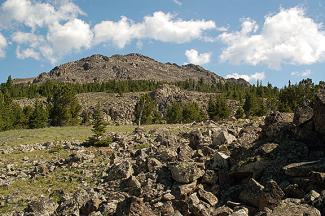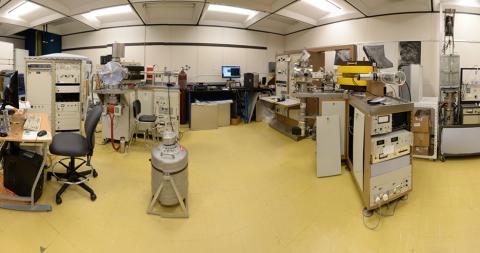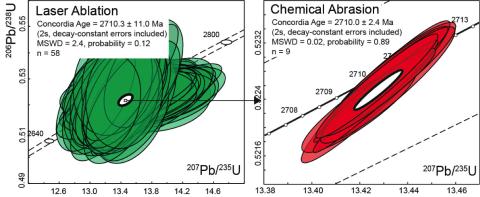By Corey Wall
Uranium-lead (U-Pb) zircon geochronology is one of the most precise techniques for resolving the rates of processes through geologic time. As a result, this method has become a major contributor to our understanding of the timescales of Earth’s processes. An important aspect of any analytical technique is the availability of well-characterized natural reference materials to allow for direct comparison of results between laboratories, for determining the accuracy of unknowns, and for assessment of systematic errors.
Laser ablation-inductively coupled-mass spectrometry (LA-ICP-MS) is now the most widely used technique for determining U-Pb dates in zircon. However, the use of naturally occurring reference materials for matrix-matched age calibration, downhole fractionation correction, and quality control is required. Most of the widely available zircon reference materials are younger than 1 Ga and, as a result, there are currently no materials that are age-matched for much of the geologic timescale.

To initially characterize a natural reference material, a method must be established to determine the true value of the material under question, whether for U-Pb geochronology, isotopic composition, or elemental concentration determination. Chemical abrasion-isotope dilution-thermal ionization mass spectrometry, or CA-ID-TIMS, has become the gold standard technique for U-Pb geochronology.

U–Pb dates for Stillwater AN2 zircon were established by several different methods: (1) conventional ID-TIMS of grains that were air-abraded, (2) CA-ID-TIMS, where grains were annealed and acid-leached prior to dissolution, and (3) LA-ICP-MS.
The U-Pb results by all methods for Stillwater AN2 zircon are concordant and yield indistinguishable concordia and weighted mean 207Pb/206Pb dates, with the latter ranging in relative precision from 2710.44 ± 0.32 Ma (n = 9) by CA-TIMS to 2710.56 ± 0.65 Ma by ID-TIMS (n = 4) to 2715 ± 9 Ma by LA-ICP-MS (n = 58).

In conclusion, the Stillwater AN2 zircon grains represent a suitable geochronological reference material that can be used for a variety of U-Pb zircon analytical methods, especially for LA-ICP-MS dating of Archean zircon, and for comparison of U-Pb zircon dating results between different analytical laboratories worldwide.
Further reading
Wall, C.J., Scoates, J.S., and Weis, D., 2016. Zircon from the Anorthosite zone II of the Stillwater Complex as a U–Pb geochronological reference material for Archean rocks, Chemical Geology, 436: 54–71.
Wall, C.J. and Scoates, J.S., 2016. High-Precision U-Pb Zircon-Baddeleyite Dating of the J-M Reef Platinum Group Element Deposit in the Stillwater Complex, Montana (USA), Economic Geology, 111: 771–782.
Scoates, J.S. and Wall, C.J., 2015. Geochronology of Layered Intrusions. In: Charlier B., Namur O., Latypov R., Tegner C. (eds) Layered Intrusions. Springer Geology. Springer, Dordrecht. pp. 3–74.